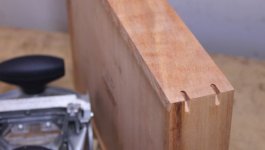I am getting ready to upgrade part of my shop and had been thinking that a better router table would be the most useful. (I currently have a Bosch router table that is okay, but nothing great.)
But my biggest motivation is to be able to cut larger mortises, such as for tables and beds. The other thing I use the router table for is to make molding, and that works fairly decently.
It occurred to me that for the price of a better Jessem table with lift and fence, etc. I could get a domino 700. In fact, the 700 might be cheaper.
I was wondering whether anyone here has any thoughts that they could share. Would I be better off with a high quality router table? Or would the Domino 700 be better?
By the way, my disposable income goes pretty much exclusively into wood working, so this is where I spend. Also, having made a variety of jigs and also having used some very nice tools, I am definitely not going to build anything. My plan is to buy a well designed and made tool.
Re jigs and what not, I have used routers and table saws, and made a variety of jigs to cut mortises and tenons. I consider it an important part of my development, but that is not where I want to put my time and energy. I am looking for accuracy, speed, and efficiency with this next upgrade.
Also, I recently bought the Festool 6 inch sander and hooked it up to a Makita dust extractor. That really opened my eyes to what great tools can do for you and how they can make working a lot more enjoyable. I also have the Festool Domino 500, but it didn't wow me the way the sander did.
Sorry if that was a bit too much disorganized blather.
Thanks,
Rene
But my biggest motivation is to be able to cut larger mortises, such as for tables and beds. The other thing I use the router table for is to make molding, and that works fairly decently.
It occurred to me that for the price of a better Jessem table with lift and fence, etc. I could get a domino 700. In fact, the 700 might be cheaper.
I was wondering whether anyone here has any thoughts that they could share. Would I be better off with a high quality router table? Or would the Domino 700 be better?
By the way, my disposable income goes pretty much exclusively into wood working, so this is where I spend. Also, having made a variety of jigs and also having used some very nice tools, I am definitely not going to build anything. My plan is to buy a well designed and made tool.
Re jigs and what not, I have used routers and table saws, and made a variety of jigs to cut mortises and tenons. I consider it an important part of my development, but that is not where I want to put my time and energy. I am looking for accuracy, speed, and efficiency with this next upgrade.
Also, I recently bought the Festool 6 inch sander and hooked it up to a Makita dust extractor. That really opened my eyes to what great tools can do for you and how they can make working a lot more enjoyable. I also have the Festool Domino 500, but it didn't wow me the way the sander did.
Sorry if that was a bit too much disorganized blather.
Thanks,
Rene

